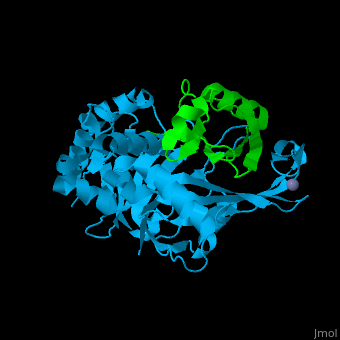Function
Thioesterase (TE) catalyzes the break of an ester bond to produce acid and alcohol at a thiol group. TEs are substrate-specific.
- Palmitoyl protein TE removes fatty acids like palmitate from modified cysteine residues during lysosomal degradation[1]. For details see Palmitoyl protein thioesterase.
- 4-hydroxybenzoyl-CoA TE converts 4-hydroxybenzoyl-CoA to 4-hydroxybenzoate and CoA[2].
- Acyl-CoA TE hydrolyzes acyl-CoA to the fatty acid and CoA and is involved in lipid metabolism[3]. See also YbgC and Mitochondrial hotdog-fold thioesterase.
- Fluoroacetyl-CoA TE from Streptomyces cattleya hydrolyzes fluoroacetyl-CoA thus preventing it from being metabolized to the lethal 4-hydroxy-trans-aconitate[4].
- Ubiquitin TE or ubiquitin carboxyl-terminal hydrolase (USP) removes conjugated ubiquitin (UB) from proteins thus regulating protein level by preventing their degradation. USP hydrolyze the peptide bond at the C-terminal glycine of ubiquitin. The USPs are involved in the processing of poly-UB precursors and of ubiquitinated proteins[5]. USP contains catalytic domain surrounded several domains: Ub-like (UBL); Ub-associated (UBA); zinc finger-Ub-specific protease domain (UBP or DUSP); TRAF homology domain.
- USP-L1, USP25 hydrolyze C-terminal adducts of UB.
- USP-L3 hydrolyzes C-terminal adducts of UB and NEDD8.
- USP5 cleaves multiubiquitin polymers.
- USP6 has ATP-independent isopeptidase activity.
- USP7, USP4, USP13, USP15 deubiquitinate several proteins.
- USP8 removes conjugated ubiquitin from proteins thus preventing protein degradation. USP8 is involved in cell proliferation and is active in the M phase of proliferation.
- USP11, USP14 are proteasome-associated.
- USP12 stabilizes T-cell complexes[6].
- USP16, USP21 deubiquitinate histone H2A.
- USP18 is a down regulator of the type I interferon signaling pathway[7].
- USP28 deubiquitinates proteins of the DNA damage pathway.
- USP33 regulates centrosome duplication.
- USP37 deubiquitinates cyclin A.
- USP46 deubiquitinates AMPA receptor[8].
Disease
Mutations in palmiotoyl protein TE cause neuronal ceroid lipocfuscinosis[9][10].
Structural highlights
. Ubiquitin thioesterase 2 active site contains the . The metal-binding enzyme contains a . The [11].
3D structures of thioesterase
Thioesterase 3D structures

